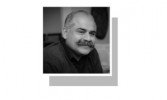IT is not for the first time that people are fighting over places of worship; and unfortunately, it appears not to be the last. After the consecration of Ram Mandir in Ayodhya recently, Varanasi, or Banaras, as it was known historically, has become the focus of another masjid-mandir controversy. A court has ordered that the mosque’s basement be opened to Hindu worshippers. The Muslim caretaker is said to be concerned about a Babri Masjid-like fate.
Ayodhya-Kashi-Mathura is the BJP/RSS ambition in terms of reclaiming India, nay Bharat, for Hindus. The Gyanvapi mosque is adjacent to the Kashi Vishwanath temple in Varanasi, which is venerated as a place where Lord Shiva manifested his presence. The temple had been attacked and destroyed many times in history, the last being on Aurangzeb’s directives. The current temple was built on an adjacent site by Ahilyabai Holkar, a female Maratha ruler, in 1780.
Mathura, also in UP, is important in the Hindu religion because it is considered the birthplace of Lord Krishna. The Keshavdeva temple, part of a complex built to mark Krishna’s janamasthan, was destroyed on Aurangzeb’s orders, and the Shahi Idgah mosque is believed to have been built on its site.
The question is if it will stop there. So far, as political expediency goes, it has to. The BJP reclaims the three sacred sites of Hinduism it considers were usurped, declares a victory, and moves on. Pushing it any further would be more than just counterproductive; it would be stupid. The ambition of projecting itself as a global power must be tempered with inclusion and restraint. All the gilded mandirs worldwide would not make India shine if it allowed exclusion’s dark shadow to eclipse it at home.
Can the region’s people interact as neighbours do?
We have all heard Allama Iqbal’s couplet:
(Those with the warmth of belief in their hearts, built the mosque overnight; this heart, an old sinner, tried for years but could not turn to prayers).
The controversy behind it is well-known but worth summarising. Around 1922, Lahore’s Hindu community built a temple in the Shah Alam neighbourhood. The Muslims insisted that a mosque be made on the adjacent plot. The matter was taken to the British court, and legend has it that the Muslims of the area overnight built a mosque to trump any adverse court order. Since the mosque was made without the requisite permission of the municipal committee, it was razed by the government. The quaint little mosque one sees presently was constructed in 1934. It would be interesting to know if the temple that spurred the Muslim fervour to build the mosque overnight, with shops on the ground floor, is anywhere to be found today. One is reminded of Jamal Ehsani’s couplet:
(Even such people have notions of changing the world; who first include shops in their home’s design).
Let us admit that we have all done wrong or have been brainwashed into believing stuff that does not reflect the whole truth. The destruction wrought by Mahmud of Ghazni, including the sack of the Somnath temple, is still taught in schools.
Most readers would know that famous Indian author Khushwant Singh wished to be buried in Hadali, a town in Khushab, Pakistan, where he was born in 1915. A plaque outside his school commemorates its illustrious student who, among his other scholarly achievements, wrote one of the most comprehensive histories of the evolution of Sikhism. The plaque has Mr Singh’s ashes mixed in it. Very few would know that Jaswant Singh, a one-time BJP stalwart, a member of the Lok Sabha, leader of opposition in the Rajya Sabha; a man who held the portfolios for external affairs, defence, and finance through times as tough as the Pokhran nuclear tests, Kargil, the Kandahar hijacking, the scuttled Agra peace summit, attacks on Kashmir and the Indian parliament; wished for his ashes to be released into the Hingol river in Balochistan. His wish was fulfilled.
Is it too much to hope the region’s people could live in peace and interact as neighbours do, instead of waiting for their mortal remains to be united with the soil their ancestors called home? Variations of the following verse are attributed to Bulleh Shah, the 18th-century Sufi:
(Raze the mosque and raze the temple, but don’t raze anyone’s heart, for that is the house of the Lord.)
The writer is a poet. His latest publication is a collection of satire essays titled Rindana.
shahzadsharjeel1@gmail.com
Published in Dawn, February 15th, 2024
House of Lord
 75
75
 1
15.02.2024
1
15.02.2024
IT is not for the first time that people are fighting over places of worship; and unfortunately, it appears not to be the last. After the consecration of Ram Mandir in Ayodhya recently, Varanasi, or Banaras, as it was known historically, has become the focus of another masjid-mandir controversy. A court has ordered that the mosque’s basement be opened to Hindu worshippers. The Muslim caretaker is said to be concerned about a Babri Masjid-like fate.
Ayodhya-Kashi-Mathura is the BJP/RSS ambition in terms of reclaiming India, nay Bharat, for Hindus. The Gyanvapi mosque is adjacent to the Kashi Vishwanath temple in Varanasi, which is venerated as a place where Lord Shiva manifested his presence. The temple had been attacked and destroyed many times in history, the last being on Aurangzeb’s directives. The current temple was built on an adjacent site by Ahilyabai Holkar, a female Maratha ruler, in 1780.
Mathura, also in UP, is important in the Hindu religion because it is considered the birthplace of Lord Krishna. The Keshavdeva temple, part of a complex built to mark Krishna’s janamasthan, was destroyed on Aurangzeb’s........
© Dawn
 visit website
visit website






















 Toi Staff
Toi Staff Gideon Levy
Gideon Levy Belen Fernandez
Belen Fernandez Mort Laitner
Mort Laitner Rami G Khouri
Rami G Khouri Ali Fathollah-Nejad
Ali Fathollah-Nejad Nikkei Editorial
Nikkei Editorial
